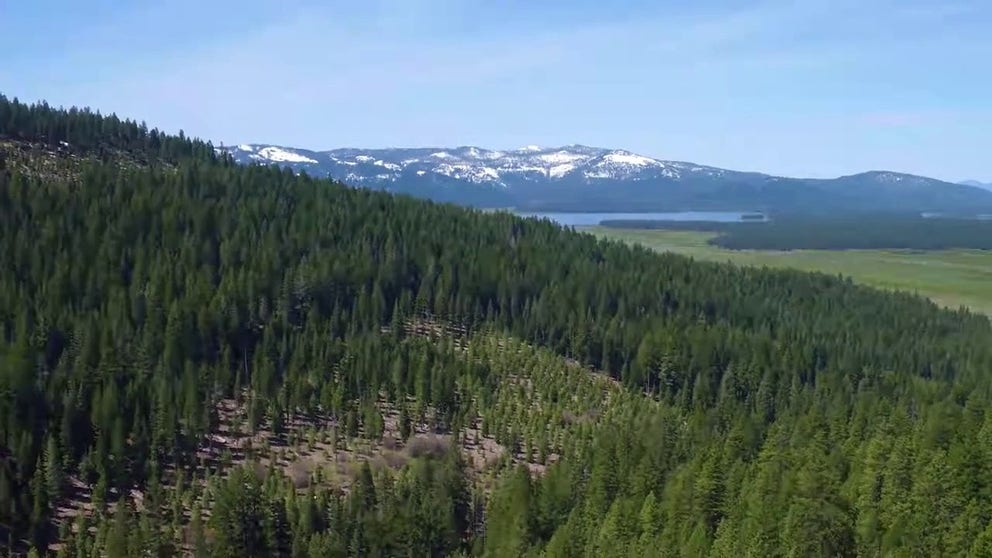California drought, wildfire threat forces closure of millions of acres to the public
California’s largest private landholder forced to close the timberland to the public, primarily due to drought.
Forestland closes to the public due to drought
Here are a few of the 1.8 million acres that Sierra Pacific Industries is closing to the public due to drought.
Persistent drought continues to take its toll on Californians. The largest private landowner in the state closed its forests to the public, primarily due to wildfire threat. One of the largest lumber manufacturers in the U.S., Sierra Pacific Industries, owns 1.8 million acres across 17 counties in the Golden State.
"It's these extreme drought conditions and the resulting increased risk of wildfire – we've closed our forest lands to public access and recreation," said Andrea Howell, spokesperson for Sierra Pacific Industries (SPI). "We know our first line of defense against wildfires is to suppress them but, we also know we have to help protect our forest resources and public safety."
NORTHERN CALIFORNIA, PLAINS AND HAWAII TOP OUTLOOK WHERE FIRE SEASON COULD BE BUSIER THAN NORMAL
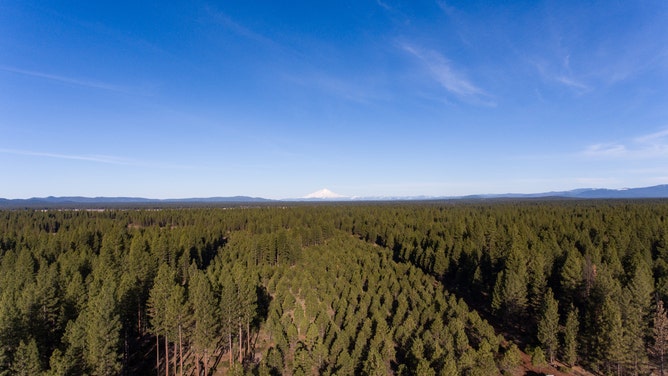
Forestland, like this one with Mount Shasta in the background, are closed to the public. Notice the new tree growth in the foreground. It was replanted after the timber was harvested.
(Sierra Pacific Industries)
This is the fourth time in five years the company took protective measures and closed their gates. Only during the summer of 2019 did their experts feel the weather and water conditions were safe enough to allow hikers, hunters, backpackers and horseback riders to traverse the timberlands.
The company's half million acres of timberland in Oregon and Washington remain open because the lands aren't experiencing severe to extreme drought.

A view of SPI land near Castle Crags State Park.
(Sierra Pacific Industries)
Climatologists say the Golden State is in the midst of a 22-year megadrought. A study in the journal Nature showed that the years 2000-2021 were the driest 22-year period in the Southwest U.S. in modern history.
ONGOING 22-YEAR DROUGHT IN WESTERN US IS DRIEST PERIOD OVER 1,200 YEARS, STUDY FINDS
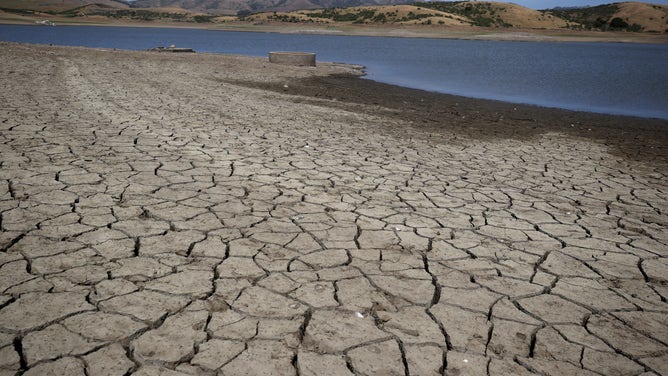
This cracked, dry reservoir bed in Northern California looks like most around the state in the third year of drought.
(Justin Sullivan/Getty Images / Getty Images)
"Despite some of the late spring rains, California is experiencing the driest conditions it has had in 1,200 years," explained Howell. "We will be regularly evaluating the situation, but we anticipate closure will remain into effect into the fall."
DROUGHT STATE OF EMERGENCY DECLARED IN CALIFORNIA AS 2021 BECOMES DRIEST IN 97 YEARS
In previous years, closures continued through the summer into October and November when weather patterns shift. SPI scientists monitor tree (fuel for fires) moisture levels, ground moisture levels, nighttime humidity levels and long-range weather forecasts to assess wildfire danger.
Long-term climate models point to drought persisting through at least August.
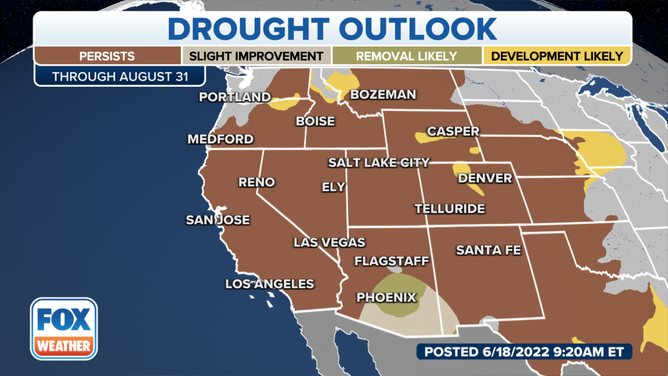
The Drought Monitor shows California drought persisting through at least August.
(FOX Weather)
A fall opening of the lands may be in jeopardy though. Meteorologists fear the dry condition will continue heading into winter, which is usually considered the rain and snow season.
La Niña, a semi-permanent weather pattern, shows signs of sticking around for a third winter. La Niña winters typically mean a dry Southwestern U.S.
LA NIñA LIKELY TO CLING TO LIFE, GIVING NUDGE TO BUSY HURRICANE SEASON, WESTERN DROUGHT
The recent U.S. Drought Monitor shows 97% of California in severe drought, 60% in extreme drought and 12% in exceptional drought.

The U.S. Drought Monitor updated on July 30th.
(FOX Weather)
Last year’s Dixie Fire blackened 63,000 acres of the company’s forest land. SPI land accounted for almost 7% of all the land lost in that wildfire that burned for over three months. Crews were able to harvest some older timber for lumber, but most of the younger trees were destroyed. The fire took out over 600 homes and 700 other structures as well.
SPI also works with the U.S. Forest Service and CAL FIRE to mitigate damage and slow wildfires. Just in the past three years, the company felled trees to create 1,500 miles of fuel breaks on their properties.
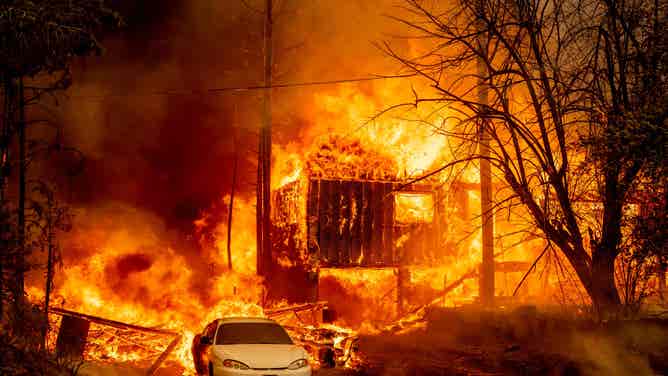
A home in historic Greenville, California, incinerated by the Dixie Fire.
(JOSH EDELSON/AFP via Getty Images / Getty Images)
"We recognize that our common forests in California are overstocked and that fires do happen. Breaks need to be put into place to provide places that, if the fire gets there or starts there, it will be less intense because there's less fuel," said Howell of the tough business decision. "Breaks also provide safe egress and ingress for those trying to get out from the fire area or in to fight a fire."
CLICK HERE TO GET THE FOX WEATHER UPDATE PODCAST
CAL FIRE was able to make a stand in one of those breaks during the deadly Camp Fire in 2018. Those firefighters were able to save Sterling City and communities around Paradise Lake. The deadliest fire in California’s history claimed 85 lives.
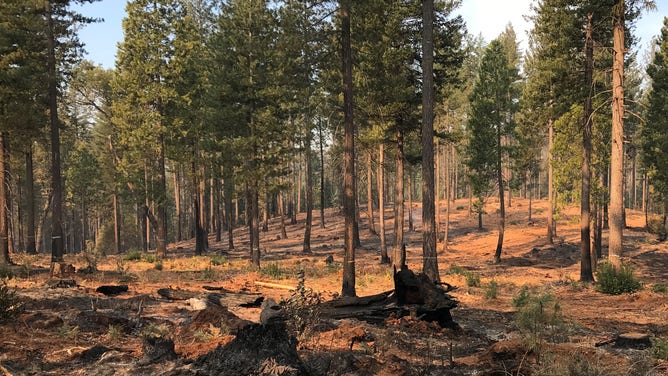
SPI cleared forested land near Paradise Lake for a fire break which ended up saving several communities from the Camp Fire.
(Sierra Pacific Industries)
SPI’s 100-year plan includes replanting harvested land with fewer trees that can grow bigger, healthier and more resistant to fire.
"They're going to grow bigger, faster and be able to withstand diseases and pests as well, which make them more susceptible to wildfire," said Howell of future fire mitigation efforts while still producing economical lumber from a sustainable forest.
Depending on the species of tree, an SPI forest grows for 60 to 80 years. Crews harvest trees in 17-acre sections on average. They replant with seedlings in one to two years. That leaves the majority of the forest open for recreation.
